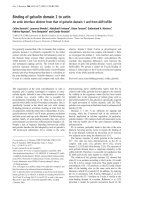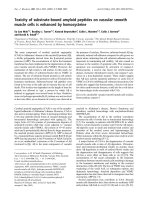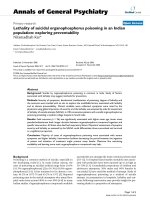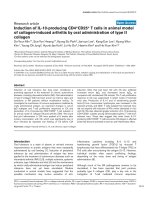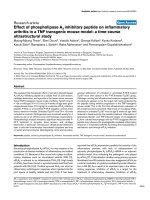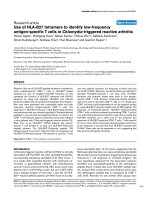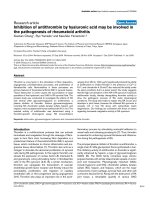Báo cáo y học: "Recurrence of suicidal ideation due to treatment with antidepressants in anxiety disorder: a case report" docx
Bạn đang xem bản rút gọn của tài liệu. Xem và tải ngay bản đầy đủ của tài liệu tại đây (212.6 KB, 4 trang )
BioMed Central
Page 1 of 4
(page number not for citation purposes)
Journal of Medical Case Reports
Open Access
Case report
Recurrence of suicidal ideation due to treatment with
antidepressants in anxiety disorder: a case report
Doron Todder*
1
and Bernhard T Baune
2,3
Address:
1
Department of Psychiatry, Ben-Gurion University, Beer-Sheva, Israel,
2
Department of Psychiatry, University of Muenster, Germany and
3
Department of Psychiatry, James Cook University, Australia
Email: Doron Todder* - ; Bernhard T Baune -
* Corresponding author
Abstract
This report describes a patient suffering from panic disorder who developed repeated suicidal
ideation specifically due to the treatment with Venlafaxine. A first suicide attempt years ago
occurred while being treated with Venlafaxine. Subsequent treatment with SSRIs or other
antidepressants involved no suicidal ideation. Re-commencement of Venlafaxine four years later
immediately led to a second suicide attempt. This unwanted effect subsided immediately after
switching to another SNRI (i.e. Duloxetine). The case report underlines the importance of onset
of suicide risk in panic disorders due to specific antidepressants.
Introduction
Since the introduction of the first specific serotonin
reuptake inhibitors (SSRI) Fluoxetine, a concern emerged
regarding the risk of developing suicide ideation as a rare
side effect [1]. During 2003, Britain's Committee on
Safety of Medicines issued a warning about the dangers of
developing suicide as side effect, first for Paroxetine and
then extended the warning to all the new antidepressants
[2]. The USA Food and Drug Administration followed,
embracing the warning for children, and then extended
the warning to adults [3].
Most of the case reports that were published on the sub-
ject dealt with depressive patients. Some of these case
reports described treatment-resistant patients or patients
who were treated with higher than common-practice drug
doses. All these drawbacks limited the ability to reach con-
clusive answers regarding the true connection between
suicide and antidepressant treatment [4].
The following description of a patient is unique because
he suffered from anxiety disorder and was neither
depressed nor experiencing suicide ideation prior to the
beginning of the antidepressant treatment. This case high-
lights the idiosyncratic response of suicidal ideation
emerging from the treatment with antidepressants.
Case presentation
We report on a 19 year-old-male patient who suffers from
panic disorder according to the DSM-IV (Diagnostic and
Statistical Manual of Mental Disorders, version IV) [5] cri-
teria since the age of 15. He was also diagnosed with co-
morbid narcissistic personality disorder, but without any
drug or alcohol abuse in the past. No medical or other
health problems were known or present. Onset of panic
attacks was at age 15 when his parents divorced. Initial
pharmacological treatment with Fluoxetine 20 mg (titered
up within a few weeks) was combined with individual
and family psychotherapy on an outpatient level. Due to
lack of response the patient was switch to Fluvoxamine
150 mg after 2 months. Despite this intensified treatment
Published: 3 December 2007
Journal of Medical Case Reports 2007, 1:166 doi:10.1186/1752-1947-1-166
Received: 3 September 2007
Accepted: 3 December 2007
This article is available from: />© 2007 Todder and Baune; licensee BioMed Central Ltd.
This is an Open Access article distributed under the terms of the Creative Commons Attribution License ( />),
which permits unrestricted use, distribution, and reproduction in any medium, provided the original work is properly cited.
Journal of Medical Case Reports 2007, 1:166 />Page 2 of 4
(page number not for citation purposes)
regimen, panic attacks continued and his overall state
deteriorated eventually leading to hospitalization to a
youth inpatient ward. Treatment was changed to Venla-
faxine initially with 75 mg/day in the morning. Almost
immediately the patient experienced frequent suicide
thoughts along with feelings of despair and hopelessness.
The thoughts frightened him to the point of suffering fre-
quent panic attacks. This deterioration was interpreted as
a sign of treatment resistance and therefore, Venlafaxine
was titered up to 300 mg/day. Subsequently, the patient
made his first suicide attempt by drinking acid that was
left by a careless hospital worker. No psychosocial factors
or stressful life events were detected to have contributed to
the suicide attempt.
Following this event, Paroxetine was trialed up to 20 mg/
d leading to almost full remission and only rare panic
attacks during the following 4 weeks. At that point in
time, when the patient was discharged home, his general
functioning was normal. In the next 4 years the patient
continued on Paroxetine 20 mg/d because when he tried
lowering this dose according to his psychiatrist, he felt
more anxious. He was regularly followed-up during this
time and experienced rare classic panic attacks mostly dur-
ing stressful times.
After 4 years of continuous antidepressant treatment with
Paroxetine, the patient started to complain about delayed
ejaculation which was attributed to Paroxetine. As a con-
sequence other antidepressants were trialed, none of
which improved his sexual disturbance or caused any
worsening of his anxiety. Finally when Venlafaxine was
trialed again due to lack of effective alternatives with no/
little side-effects, the patient complained about frequent
suicide thoughts after one week of Venlafaxine XR 75 mg.
Other medication was not used at that time. He appeared
in the outpatient clinic as very anxious, reported being
afraid to stay on his own, was terrified that he might lose
control and to unintentionally harm himself. The suicidal
thoughts were experienced in the same way as the suicidal
ideation and suicide attempt from his adolescent years.
After switching to Duloxetine 60 mg/day, the suicidal
thoughts completely disappeared.
Discussion
In the last years, several large retrospective analyses were
carried out in order to expand the understanding of the
phenomenon of suicidal ideation due to SSRI medication.
These studies pointed out that regarding the risk of devel-
oping suicide acts, the new antidepressants present with a
similar risk of suicidal ideation as the old TCA, [6,7]. It
was also concluded that antidepressants as a group elevate
the risk for suicide compared to placebo [8].
On the other hand, many studies confirm the reciprocal
connection between the increased use of antidepressants
and the decline of suicide. For example, in a study con-
ducted in Scandinavia, victims of suicide were compared
to people who died as a result of natural or traumatic
events. The suicide group was relatively undertreated with
antidepressants [9]. A more recent report applying aggre-
gated data suggests that the increased use of SSRIs is
related to decreased suicide rates whereas TCA prescrip-
tions were related to increased suicide rates [10]. On a
similar point, a retrospective analyses of the relationship
between prescriptions of SSRIs and suicide rates suggests
that the decrease of SSRI prescriptions for children and
adolescents, both in the United States and the Nether-
lands, after U.S. and European regulatory agencies issued
warnings about a possible suicide risk with antidepressant
use in pediatric patients, was associated with increases in
suicide rates in children and adolescents [11].
Combining this research the conclusion is that for the
society as a group, the use of antidepressants is beneficial.
Nevertheless, for certain individuals, these medicines
could cause suicide ideation and put them in great risk
[12]. Therefore, identifying these patients is important
from a clinical and legal perspective.
The raising awareness of the suicidal risk for developing
suicidal ideation and behavior during treatment with anti-
depressants causes a dramatic change of the attitude
toward these drugs. The presented case demonstrates for
the first time a recurrence of suicidality following antide-
pressants in patients with anxiety disorder. Therefore, sui-
cidality as a direct consequence of antidepressant
treatment is not restricted to patients with major depres-
sive disorder. Improved understanding of the risks and
detection of early clinical warning signs while using anti-
depressants is therefore vital for these patients.
The understanding of the precise mechanisms by which
antidepressants may cause suicidality is still lacking. Few
theories were put forward along the years that can be
divided into two groups: either attributed to depressive
symptoms or attributed to the drug itself. Theories about
attribution to depressive symptoms claimed that this phe-
nomenon is merely a consequence of a clinical worsening
of the specific disorder which is known as the "paradoxi-
cal suicide" [12,13]. Others speculated that these patients
may suffer from an undiagnosed bipolar disorder [14].
Theories that focus on side effect of the drug claimed that
the development of akathisia due to antidepressant treat-
ment possibly is the cause for suicidality [15]. Beyond
these explanations, our case contributes to other theories
as follows. Idiosyncratic response to psychotropic agents
might have occurred in both susceptible individuals as
suicidality subsided when switching to another drug of
Journal of Medical Case Reports 2007, 1:166 />Page 3 of 4
(page number not for citation purposes)
the same class. This theory gains more strength when con-
sidering that even treatment of normal subjects could
result in suicide ideation [4]. Furthermore, a sudden onset
of suicidal feelings is a well known but still relatively
underestimated and not widely understood phenome-
non. Patients often describe feelings of hopelessness and
despair that may develop after starting treatment with an
antidepressant [12] that may lead to suicidality. The clas-
sical action of the reserpin can serve as a model for such
action. In addition, auto-aggressive feelings are possibly
part of panic attacks as reported by George et al. who
described three patients developing auto-aggressive and
suicidal thought during panic attacks [16]. The authors
described the suicidal ideation as sudden "attacks" resem-
bling panic attacks.
Hypothetically, biological alterations in the serotonergic
system might have contributed to the suicidal ideation/
attempt in the presence of an SSRI whereas this effect
ceased with the pure NSRI was used. The following mech-
anism for a reduced serotonergic activity induced by SSRI
can be suggested as an explanation of our case observa-
tion. It is reported that the increase of the concentration of
5-HT in the extracellular brain space through most antide-
pressants by preventing its reuptake is offset by a negative
feedback operating at the 5-HT cell-body level [17]. It was
shown that the inhibition of 5-HT reuptake produced by
administration of SSRIs can cause a marked enhancement
of the extracellular concentration of 5-HT in the midbrain
raphe nuclei [18-20] and accounted for the suppression of
5-HT cell firing [21,22]. Consequently, the presence of an
SSRI can lead to a reduced activity of serotonin-mediated
neuronal activity possible related to abnormal behaviour
such as suicidal ideation. Unfortunately, since it was not
possible to clarify the biological/serotonergic make-up of
our case, these assumptions require further investigations.
Conclusion
Nearly all research on suicide rates that show biological
[23], psychological [14,24] and social [25] factors that
contribute to suicide risk, do not differentiate explicitly
between risk for depression and anxiety disorders. More
specifically, little attention has been given to and no clin-
ical experience reported, if modern antidepressants do
contribute to suicide risk in anxiety disorders [4]. More
clarity on the diagnosis specific suicide risk appears to be
important for clinical practice and also for the under-
standing of the underlying mechanisms of suicide risk due
to antidepressants. An enhanced understanding of the
anxiety specific suicide risk might help to improve clinical
practice to anticipate and early identify individuals devel-
oping suicidal ideation while treated with antidepres-
sants.
Conflict of interests
The author(s) declare that they have no competing inter-
ests.
Authors' contributions
DT was the treating psychiatrist of the patient. Both DT
and BB drafted the manuscript, read and approved the
final manuscript.
Consent
Written informed consent was obtained from the patient
for publication of this case report and any accompanying
images. A copy of the written consent is available for
review by the Editor-in-Chief of this journal.
Acknowledgements
Written consent was obtained from the patient for publication of the study.
References
1. Teicher MH, Glod C, Cole JO: Emergence of intense suicidal
preoccupation during fluoxetine treatment. Am J Psychiatry
1990, 147(2):207-210.
2. UK Medicines and Health Care Products Regulatory Agency, release.
DH: Seroxat must not be used for treatment of children.
2003.
3. Akiskal HS, Benazzi F: Does the FDA proposed list of possible
correlates of suicidality associated with antidepressants
apply to an adult private practice population? J Affect Disord
2006, 94(1-3):105-110.
4. Healy D: Lines of evidence on the risks of suicide with selec-
tive serotonin reuptake inhibitors. Psychother Psychosom 2003,
72(2):71-79.
5. APA: Diagnostic and Statistical Manual of Mental Disorders
[4th ed] (DSM-IV). 1994.
6. Simon GE, Savarino J, Operskalski B, Wang PS: Suicide risk during
antidepressant treatment. Am J Psychiatry 2006, 163(1):41-47.
7. Jick SS, Dean AD, Jick H: Antidepressants and suicide. Bmj 1995,
310(6974):215-218.
8. Fergusson D, Doucette S, Glass KC, Shapiro S, Healy D, Hebert P,
Hutton B: Association between suicide attempts and selective
serotonin reuptake inhibitors: systematic review of ran-
domised controlled trials. Bmj 2005, 330(7488):396.
9. Isacsson G, Holmgren P, Ahlner J: Selective serotonin reuptake
inhibitor antidepressants and the risk of suicide: a controlled
forensic database study of 14,857 suicides. Acta Psychiatr Scand
2005, 111(4):286-290.
10. Gibbons RD, Hur K, Bhaumik DK, Mann JJ: The relationship
between antidepressant medication use and rate of suicide.
Arch Gen Psychiatry 2005, 62(2):165-172.
11. Gibbons RD, Brown CH, Hur K, Marcus SM, Bhaumik DK, Erkens JA,
Herings RM, Mann JJ: Early evidence on the effects of regula-
tors' suicidality warnings on SSRI prescriptions and suicide in
children and adolescents. Am J Psychiatry 2007,
164(9):1356-1363.
12. Healy D, Langmaak C, Savage M: Suicide in the course of the
treatment of depression. J Psychopharmacol 1999, 13(1):94-99.
13. Healy D:
The three faces of the antidepressants: a critical
commentary on the clinical-economic context of diagnosis.
J Nerv Ment Dis 1999, 187(3):174-180.
14. Akiskal HS, Benazzi F: Psychopathologic correlates of suicidal
ideation in major depressive outpatients: is it all due to
unrecognized (bipolar) depressive mixed states? Psychopathol-
ogy 2005, 38(5):273-280.
15. Rothschild AJ, Locke CA: Reexposure to fluoxetine after serious
suicide attempts by three patients: the role of akathisia. J Clin
Psychiatry 1991, 52(12):491-493.
16. George DT, Anderson P, Nutt DJ, Linnoila M: Aggressive thoughts
and behavior: another symptom of panic disorder? Acta Psy-
chiatr Scand 1989, 79(5):500-502.
Publish with BioMed Central and every
scientist can read your work free of charge
"BioMed Central will be the most significant development for
disseminating the results of biomedical research in our lifetime."
Sir Paul Nurse, Cancer Research UK
Your research papers will be:
available free of charge to the entire biomedical community
peer reviewed and published immediately upon acceptance
cited in PubMed and archived on PubMed Central
yours — you keep the copyright
Submit your manuscript here:
/>BioMedcentral
Journal of Medical Case Reports 2007, 1:166 />Page 4 of 4
(page number not for citation purposes)
17. Celada P, Puig M, Amargos-Bosch M, Adell A, Artigas F: The thera-
peutic role of 5-HT1A and 5-HT2A receptors in depression.
J Psychiatry Neurosci 2004, 29(4):252-265.
18. Adell A, Artigas F: Differential effects of clomipramine given
locally or systemically on extracellular 5-hydroxytryptamine
in raphe nuclei and frontal cortex. An in vivo brain microdi-
alysis study. Naunyn Schmiedebergs Arch Pharmacol 1991,
343(3):237-244.
19. Bel N, Artigas F: Fluvoxamine preferentially increases extra-
cellular 5-hydroxytryptamine in the raphe nuclei: an in vivo
microdialysis study. Eur J Pharmacol 1992, 229(1):101-103.
20. Invernizzi R, Belli S, Samanin R: Citalopram's ability to increase
the extracellular concentrations of serotonin in the dorsal
raphe prevents the drug's effect in the frontal cortex. Brain
Res 1992, 584(1-2):322-324.
21. Blier P, de Montigny C: Current advances and trends in the
treatment of depression. Trends Pharmacol Sci 1994,
15(7):220-226.
22. Quinaux N, Scuvee-Moreau J, Dresse A: Inhibition of in vitro and
ex vivo uptake of noradrenaline and 5-hydroxytryptamine by
five antidepressants; correlation with reduction of spontane-
ous firing rate of central monoaminergic neurones. Naunyn
Schmiedebergs Arch Pharmacol 1982, 319(1):66-70.
23. Souery D, Oswald P, Linkowski P, Mendlewicz J: Molecular genet-
ics in the analysis of suicide. Ann Med 2003, 35(3):191-196.
24. Flouri E: Psychological and sociological aspects of parenting
and their relation to suicidal behavior. Arch Suicide Res 2005,
9(4):373-383.
25. Compton MT, Thompson NJ, Kaslow NJ: Social environment fac-
tors associated with suicide attempt among low-income
African Americans: the protective role of family relation-
ships and social support. Soc Psychiatry Psychiatr Epidemiol 2005,
40(3):175-185.

